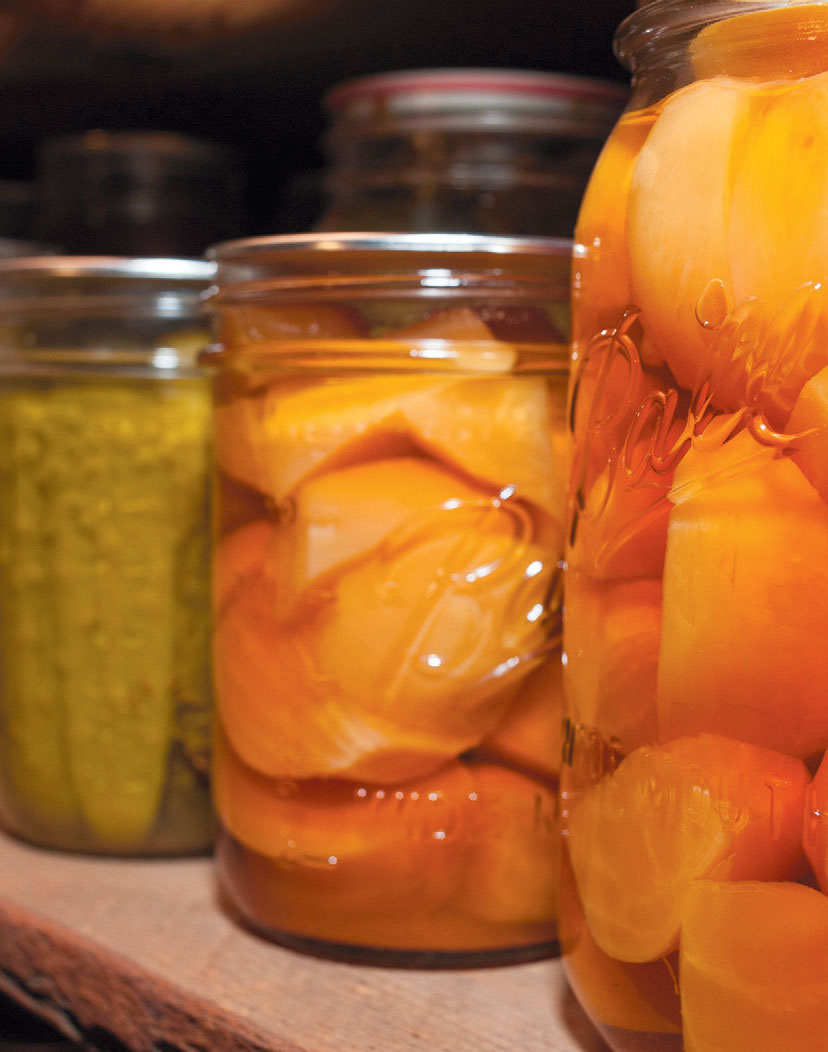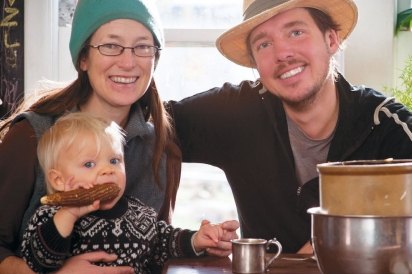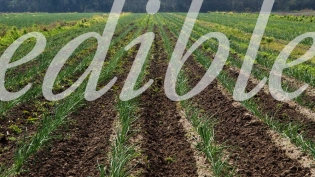The No-Shopping Local Food Challenge: Month of Pantry, Month of Plenty
Anyone who voluntarily opts out of a commercial transaction as fundamental and frequent as buying groceries is bound to be met with some measure of incomprehension or possibly even suspicion. Such responses may not be comfortable, but they often point out a prominent societal fault line and encourage further inquiry.
I recently had the opportunity to interview two couples in the Grand Traverse region who have undertaken the winter practice of a monthlong “no-grocery challenge.” At first blush this may sound like an austere exercise, but in truth it is just the opposite. Equal parts personal challenge, pantry and freezer cleanup, and celebration of local food, the prospect of a month without shopping prompts a reconsideration of foodways and habits, and demands a degree of culinary creativity.
Jess Piskor and Michelle Ferrarese, of Bare Knuckle Farm (Northport) and Birch Point Farm (Traverse City) respectively, welcomed me into a kitchen brimming with the cozy hum of good use. An impressive array of spices, dry goods and hand-labeled jars of all sizes sprawled across the shelves around us. Jess and Michelle’s son, Rudy, reveled in newfound ambulatory freedom, marching confidently around with a parade of small objects while his parents and I spoke.
I also interviewed Jennifer and Jordan Yeatts of Traverse City in their open-layout kitchen, which is a triumph of spatial optimization. They have thoughtfully designed their cooking and eating space to be as open as possible while housing exactly the storage and infrastructure they need and nothing more. When they first told me they made do with only a dorm-sized fridge, I was skeptical. How could a household that so values and celebrates good food place such a stringent limit on their cold storage? That was before I fully appreciated the potential of a strong foodrescue ethic amplified by smart preservation systems—ideals that Jordan and Jennifer realize daily.
I asked the interviewees the same set of nine questions, and although a few striking differences emerged in their answers, it turned out that these couples share a good deal of common ground in both philosophy and method. The interviews will follow.
Northwestern lower Michigan is fortunate to have a robust local food network—producers and consumers who are investing in the biological and cultural capital that will allow local foods to become more available. Our communities are familiar with the fluctuations of the seasons, and even though not everyone aligns their diet with local availability, most understand the tough budgetary realities of a northern winter. By incorporating more food preservation into our seasonal routines, we can bank up our food budgets for the colder months, and we can spend more of our dollars locally.
I am not advocating a reactionary return to the olden days, but I do see value in challenging the contemporary model of apparent superabundance. The “no grocery challenge” is one step in this direction. Environmentally, we are seeing the effects of reaching the natural limits of the great blue ark we call home. As Ben Lerner puts it, “You cannot use the planet and expect to end up with a planet.” I don’t know if I quite share that grim view, but there is an important logic at work behind it. Limits are real and we have to learn to live within them, although that doesn’t mean we can’t have fun while creatively doing so.
Michelle, who has a gift for bringing the conversation back to the human scale, puts it into perspective: “Learning to operate one or two seasons at a time entails a mindset that is somewhere between the apocalyptic hoarder and the ‘just go buy whatever you need that day.’ It takes practice, but it’s great.”
THE NO-SHOPPING CHALLENGE
JENNIFER AND JORDAN YEATTS, TRAVERSE CITY
EGT: What prompted you to undertake this No-Shopping Challenge?
Jennifer: It started out with a dollar-a-day challenge. We were living in Idaho at the time. We always tend to have an abundance of food, and we thought, “How long will this stockpile get us? How creative can we get?” There are always things that hide in your freezer and you forget they’re even there.
Jordan: Yeah, there were some budgetary considerations as well, but mostly we just wanted to make use of what we had. We have developed this food preservation habit as a couple. I mean we grew up canning a bit, but we really jumped into it when we moved to Idaho. There was a great farm market, with bulk quantities of organic tomatoes and peaches.
Jennifer: Those were the easiest things to start with, canning-wise, since they’re so straightforward. My mom came out and helped us can and then we kind of took it from there. Having the guidance of someone who had done it for years and years made it more doable.
EGT: How long has this been a winter practice for you?
Jordan: We started in February 2010.
Jennifer: It was the shortest month, so it was the easiest one to start with.
Jordan: Last year was the first year that we went for two months without spending anything. Near the end of the first month we saw we had barely scratched the surface [of our food stores], so we kept going.
EGT: What food storage capabilities or infrastructure do you have at home?
Jennifer: In Idaho, we were stacking things along the floor.
Jordan: Canned goods.
Jennifer: Yeah, canned goods were lining the edge of the baseboard in our small apartment, and a few were on shelves. When we bought this house, we immediately downsized from the full-sized fridge to the dorm-sized fridge. And the kitchen felt so good! No constant hum, no behemoth getting in the way of everything. But this house came with an upright freezer, which was perfect for what we wanted to do.
EGT: Where do you source the foods that you put up for the wintertime, and what kind of planning does that entail?
Jordan: Some of it is from our CSA (community-supported agriculture) share with Loma Farm.
Jennifer: Some is additional quantity from Loma and other farms. If we plan to can tomatoes or something, we’ll purchase additional flats, usually at a discount.
Jordan: Also, both in my previous job at Oryana and now at Cherry Capital Foods, I’ve been able to rescue marginal food destined for the waste stream that—with enough prep work—is still edible.
Jordan: When we lived on Old Mission Peninsula we were right next to an orchard with a farm stand…
Jennifer: …and they would dump out food that didn’t sell into a pile underneath one of the trees. One day Jordan came home and said, “I’ve got good news and I’ve got bad news, which do you want first?” The good news was that there were two bushels of free peaches outside and the bad news was that there were two bushels of free peaches outside...that needed to be dealt with right then. You had to work at the bakery early the next morning, so I stayed up til 3 AM canning peaches.
EGT: What is your favorite preserved food to tuck into in the depths of winter?
Jordan: Peaches. Halved peaches in light syrup.
Jennifer: Yep, those are delicious midwinter.
EGT: What tempts you when you are entering the home stretch of the challenge? Do you start to miss certain foods?
Jennifer: Last year it was peanut butter. We ran out of peanut butter and that was one of the first things on my list to purchase.
Jordan: We were also out of some staple, maybe corn starch or something like that.
Jennifer: There are some things you just can’t make if you don’t have certain staples, but we usually find ways of making something special and delicious with what we have.
Jordan: One other thing that makes it possible is getting coffee through Jennifer’s work at Higher Grounds.
Jennifer: That’s true, I didn’t think about that. We get a weekly allotment of free coffee. If I didn’t have that, then that would be a factor.
EGT: Do you find that your meal planning changes at all during the challenge?
Jordan: We put a little bit more thought into the planning when we’re on top of our game. Half the time, maybe, we do go through the calendar and pencil in meal ideas for the month.
Jennifer: When we do, it’s really helpful because I can look through the calendar and say, “Oh, I have to take that out of the freezer to thaw.” Or something might have to be prepped or marinated.
Jordan: Yeah, it becomes more important during that month to think ahead in that way.
EGT: How have your reasons for continuing this project evolved over time?
Jennifer: It did originally line up with budgetary considerations. We eat very well. We value food as a significant part of our budget, and we’re happy to do that. So it was a way of balancing that a little bit. And it’s a fun personal challenge, too. It’s a fun winter project.
Jordan: It sparks conversation, too, and hopefully thoughtfulness in others. I definitely have had coworkers last year at Oryana who were shocked or surprised.
Jennifer: Jordan develops a reputation. People know he doesn’t like to throw away food, which is great. I love that. It can be silly, but it’s great.

EGT: What advice do you have for others who might consider tackling a No-Shopping Challenge of their own?
Jennifer: Do a freezer inventory. I know not everybody has a full freezer, but a lot of people have things in their freezer that have been hiding there for a long time. List everything out, prioritize what’s been in there the longest, make a meal plan and use it. Every time we do a freezer inventory, we discover things we forgot about. Keep that list right there by the freezer, and get better about labeling.
Jordan: Going into it, we also stocked up on our flour and other staples.
Jennifer: Right, we’re not unreasonable about it. We’re going to make sure we have the basics. Adequate chocolate, too. But it’s not a pain, it’s fun. Sometimes we get the reaction, “Isn’t that difficult?” But it’s enjoyable.
Jordan: And it’s not like we hunker down for the month, either. I mean, we feed people.
Jennifer: It feels good to be able to share high-quality food. To see something that wasn’t going to be used by anybody end up satisfying or even thrilling a dinner party, that’s awesome. Put a tiny dent in all that food waste in our country. day-to-day life.
NO-SHOPPING CHALLENGE
JESS PISKOR AND MICHELLE FERRARESE, LEELANAU COUNTY
EGT: What prompted you to undertake a No-Shopping Challenge?
Michelle: We always have a meaningful challenge to grow and preserve our own food, but that one year we realized we had more than two years’ worth of frozen and canned goods to  use up. We just said, “This is silly, let’s clean out our pantry and our freezer.”
use up. We just said, “This is silly, let’s clean out our pantry and our freezer.”
Jess: Anybody who has a freezer has food that just sits there, you know, and this idea was to actually use that food. It’s about retraining our brains that it’s actually easier to look in the freezer than go to the store. That’s food you’ve already prepped, that you’ve already put energy into.
EGT: How long has this been a winter practice for you?
Jess: Early 2014, maybe? It was something I’d tried to do before, slightly differently—I tried to eat local for a year. I think both Michelle and I are motivated by food challenges.
Michelle: I’m motivated by long-term life choices, like the fact that we grow most of our own produce and we try to barter with other producers for what we don’t grow. Obviously we buy stuff, too, but the central tenet of it for me is to try to be self-sustainable. And it’s not hard because we live in this region where the agricultural diversity is mind-blowing for a temperate zone.
EGT: What food storage capabilities or infrastructure do you have at home?
Michelle: Because we live on the farm we have a lot of storage capacity. We have a walk-in cooler.
Jess: You want to have your basement insulated, we just learned, but at the same time it’s an advantage to have this one corner poorly insulated because that keeps it really cool and we can treat it as a root cellar.
Michelle: I think the lowest-tech thing is the root cellar, and then we have three freezers. A chest freezer, an upright freezer and the fridge/freezer. And we have a lot of storage space in the basement that we use for canned goods, and various fermenting projects. We usually keep either kraut or kimchi going.
Jess: I’ve been doing a little bit of drying, too. Mostly herbs and hot peppers.
EGT: Where do you source the foods that you put up for the wintertime, and what kind of planning does that entail?
Jess: A lot of it we grow ourselves. Potatoes, carrots, onions, greens, herbs. Other things we trade for or get from other farmers—mushrooms, fruit and dairy. But another big part of our diet is things like pasta and rice, and other staples, which we buy.
Michelle: We always have bags of what we call “Wareberries” in the freezer from Ware Farm. Blueberries or strawberries, doesn’t matter, they’re Wareberries. It’s fun to dig out two-year-old berries because it brings back that memory of the week you either picked the berries or bought them at market and talked to Sandy Ware and she told you there were just so many strawberries that they didn’t know what to do with them, or maybe they were so few and far between that you were lucky to get a quart—let alone a flat—to freeze. So every little thing in your freezer tells a story.
Jess: Something that my business partner Abra Berens does every time she cans something, in addition to writing what it is and where it’s from, is to write just a two- or three-word snapshot of what’s going on right that moment. She’ll write “Lightning storm outside,” or “Too cold to be at the farm,” so opening up that jar later connects you back to the time it was made. It’s really fun.
EGT: What is your favorite preserved food to tuck into in the depths of winter?
Michelle: Frozen corn and anything pickled, for me.
Jess: For me, it’s cured meats and cheeses.
EGT: What tempts you when you are entering the home stretch of the challenge? Do you start to miss certain foods?
Jess: Fresh dairy was the biggest challenge. I love cheese and sour cream, and those were really hard not to have.
Michelle: For me, it was coffee. One of the things that we didn’t realize we used a lot of was anything with caffeine in it. After the coffee, we went through the black tea, then we got to the green tea stash before the month was over. I think we were good on salt but I can imagine that if we didn’t have a big box of salt that would be a limiting factor.
EGT: Do you find that your meal planning changes at all during the challenge?
Michelle: Over the years we have gotten better at doing “meal planning” in the summer by freezing things we have already cooked huge batches of, like ratatouille or chili. We also eat a lot of slaw. Cabbage slaw, carrot slaw, radicchio slaw, endive slaw. Shredded anything with something piquant like vinegar or lemon, ginger and salt. It’s a good source of vitamin C. We’ve never gotten scurvy, so that’s worth noting.
EGT: How have your reasons for continuing this project evolved over time?
Michelle: When I first started doing any kind of preserving, it was because I was fascinated with self-sufficiency. It’s the same thing that happened with farming, all the cool kids were doing it. After a while it just becomes part of your life and you can’t imagine not doing it. Your habits form as an adult, for better or worse… Having these habits of growing and preserving food makes it harder to think about switching back to more of a shopping mentality. How to make food for Rudy, with him, in spite of him, has been a huge challenge but it reinforces that growing and preserving a lot of what we need is fun.
Jess: It comes down to not wanting to be a hoarder. We grow all this food, we put it up and we stick it in our root cellar. And it’s food: It’s meant to be eaten. We aren’t living in apocalyptic times where we have to have a giant cellar with two years worth of food. Let’s eat through what we’ve got so when we see new food we can be excited about it and have space for it.
EGT: What advice do you have for others who might consider tackling a No-Shopping Challenge of their own?
Jess: People want to help, but it’s funny because we didn’t deprive ourselves at all.
Michelle: I had four different offers from people who said they would meet me in a dark alley with a chocolate bar.
Jess: Be creative, don’t be afraid. You’re not gonna mess it up. Make some food, make it with love. It’s going to taste good.
Michelle: I would say get to know your local farmers and other sources of food. Try lots of new things.
Jess: And if you’re sick and tired of eating from your pantry, call up some friends and go over to their house. Also, don’t make hard and fast rules about food. When you start to say, “I’ll never do this, I’ll always do that,” it makes food stressful, and eating should be a time of celebration and excitement.
Michelle: We live in weird times that we have to contrive limits for ourselves in order to get excited about food. So I think maybe the longer-term benefit of learning to eat locally, and learning to produce and preserve our own food, is that there’s inherent joy in it. The challenge becomes more meaningful when you embrace it in your









